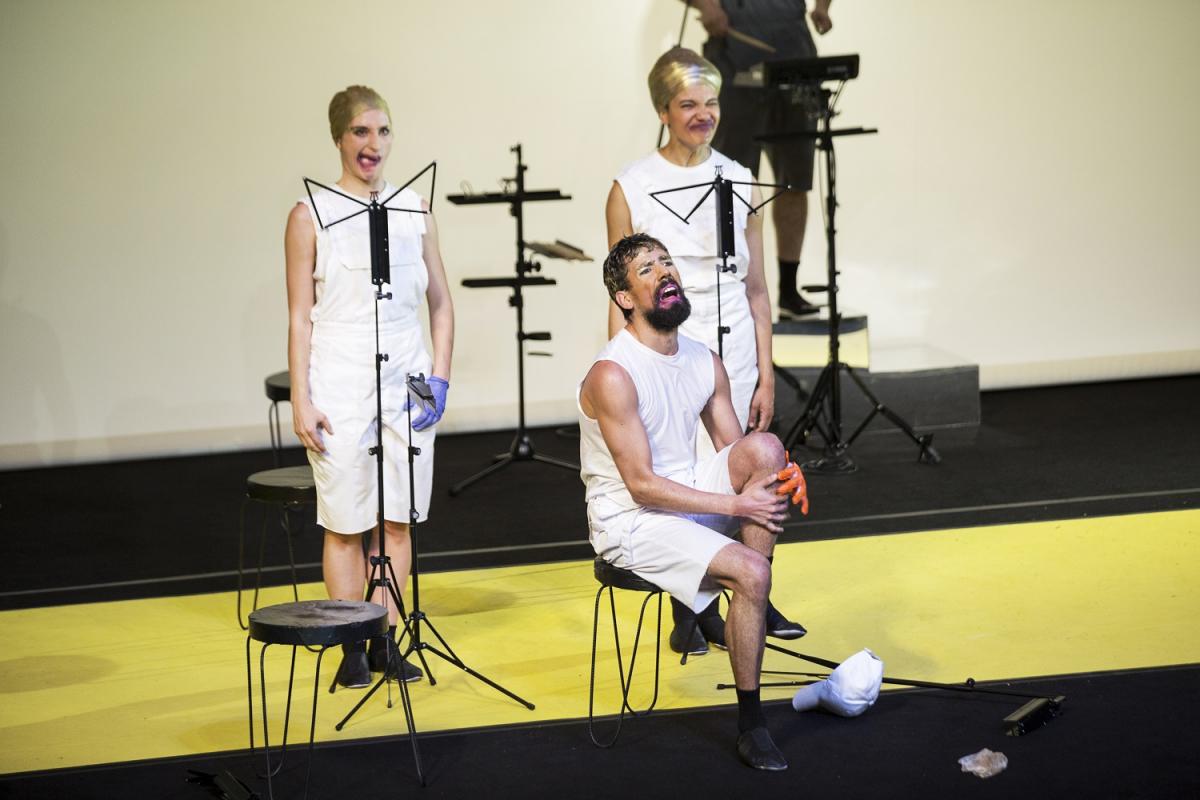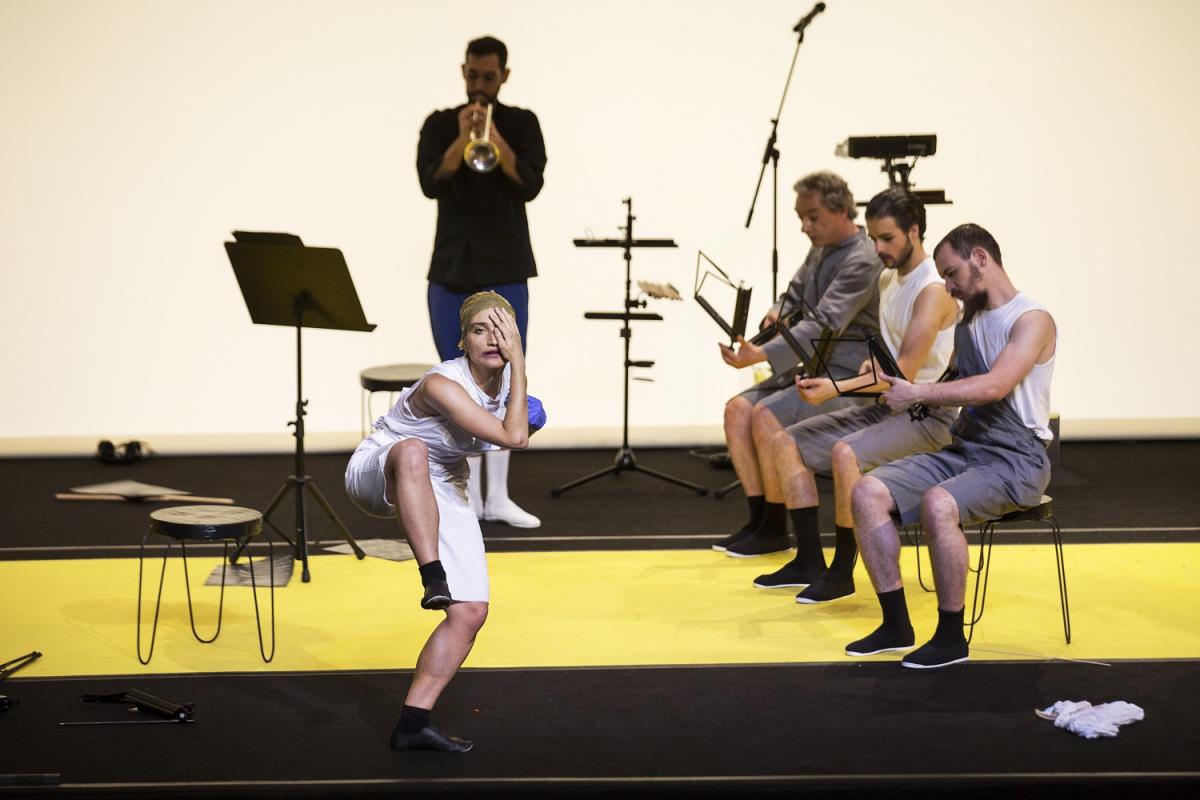
Bacantes at FITEI 2017.
If you’ve ever been to Porto, you might remember its imposing, picture-perfect Dom Luis bridge over the River Duoro, its fourteenth century churches and Art Deco theatres, the Rem Koolkhaas-designed Casa de Musica or Portugal’s most famous contemporary art museum, Serravlves. The Duoro meets the Atlantic Ocean, some distance from the city lined with cobbled streets and lit by gleaming, slightly frosty sunshine. Porto’s centre was declared a UNESCO World Heritage Site in 1996, and is a former Roman Empire outpost known for its exporting of port. But this is not quite the Porto I’ve come to know. This is a city that struggles with its contrasts, whose citizens are divided by the fiscal policies that have come to govern so much of Southern Europe, where gentrification is fought by community organising and local activism, and where cultural infrastructure relies on the agency and commitment of local movers and shakers, as opposed to any one form of governmental support.
Despite a considerable rise in tourism, Porto, like many cities of its kind, doesn’t benefit from any trickle down economic model. Instead, it’s wrapped in a globalised economy that favours status and image over welfare. Porto is, to me, a city of encounters and grassroots engagement; a city that reflects on its public spaces, but also a divided city, whose histories are marked on its buildings. Many of my encounters with Porto have involved navigating parts of the city off the beaten track: alleyways with family run restaurants, apartments in theatre buildings, baroque, pre-modernist and Art Deco buildings and old police stations. Areas, in short, that have escaped modernisation, and are often characterised by ragged furniture and make shift spaces.
The Porto I’ve come to know – by walking its squares, thinking with some of its people, walking down the Duoro, eating fish by the ocean and sitting in its theatres – is one activated by its cultural community and sense of civic engagement. It’s a place struggling with its identity but refusing to fetishize dereliction or ignore stark economic and political battles. In the words of Richard Foreman, Porto is a city that is exploring the possibility of growing into what it is not yet.
I am here for my third FITEI (Festival Internacional de Teatro de Expressao Iberica), this year celebrating its fortieth anniversary under the artistic direction of Goncalo Amorim. The festival is home to a wide-range of work from Portugal and beyond, and engages as much with diasporic and other Portuguese-speaking communities as with the local, situating itself in relation to the Iberico-American scene. This year, the festival is themed around ‘community and memory’, engaging with Portugal’s colonial history and the Salazar regime, as well as more contemporary issues surrounding identity politics from micro to macro. This is a place that has much to reveal about the ways in which communities remember; it exists at the confluence of geopolitical change and local resistance, and because of that FITEI takes a very specific approach to showcasing and presenting performance. The festival also introduces the notion of post-memory; thinking about what happens after remembering as much as what happens instead of remembrance.

Joana Craveiro’s ‘Living Museum’. Photo: Joao Tuna
This play on memory and community unfolds through contrasts and engagement. One of the most exciting artists working with documentary theatre today in Portugal, Joana Craveiro, returned to the festival this year with a workshop on memory and approaches to collective remembrance. Her piece, The Living Museum of Small, Forgotten and Unwanted Memories, which she present in a prior edition of the festival, stretches over five hours and takes the form of a lecture performance framed by a prologue. Although the artist was working with documents of the Salazar regime, including books, journals, records, newspaper clippings, outfits and more, the performance blends imagined and real narrative segments with explorations of left-wing resistance and its formation leading up to the seventies and what she terms the ‘post-generation.’
You don’t simply witness The Living Museum, as much as become engulfed by it. The audience finds different threads to follow as the work constantly repositions what they’re hearing throughout their own narrative relationship to history – its visibility and the power of lived experience to reveal and conceal. Craveiro’s workshop, titled Laboratory for a Troubled History, is part of FITEI’s This is not a School, a festival-wide, free and open programme of workshops, talks and critical reflection that intersects with and weaves around the programme co-curated with Rui Pina Coelho. In her workshop Craveiro explores the ‘problematic history of Portuguese colonialism’ in dialogue with the process of decolonisation that began in the mid-seventies, and considers the performative presentation of history that can emerge from personal documents, be they material or embodied.

‘By Heart’. Photo: Duarte Silva
Memory also plays a more direct part in reflections on the theatrical moment, particularly in the work of Tiago Rodrigues, whose pieces By Heart and Anthony and Cleopatra distinctly explore this dynamic. By Heart sees ten self-selected audience members undertake learning a Shakespearian sonnet by heart. The piece is interspersed with narrative fragments, stemming from the director’s own encounter with a passing family member who, before losing her memory entirely, asking him to recommend a final book to read, as well as excerpts by George Steiner, Ray Bradbury and Joseph Brodsky (yes, mostly white men, frustratingly so). The ten audience members have to learn a couple of lines each, whilst also working collectively. The process of witnessing this becomes an intriguing, evocative and critical take on what it takes to remember, and our positioning and relationship to the performativity of memory. It seems apt, then, to also call into question the homogeneity of the sources, the authors of which, despite working under considerable political or cultural pressures, adhere to a small, if dominant cultural category. I can’t help with feel that identity politics matter significantly in our collective thinking about memory, and our spectatorial attention or civic engagement.
Rodrigues’ second piece, Anthony and Cleopatra, is a choreographed duet with Sofia Dias and Vitor Roriz, a real-life couple, which riffs on Shakespeare’s play through a particular focus on a kind of expressive domesticity. At the heart of the piece is a process of description, and a reflection on the subjectivity and gender politics of speaking about what you see. Anthony speaks for Cleopatra, and vice-versa; they describe movements and tensions. What becomes apparent is a tension beyond the two, and the suggestion of any romantic relationship that might be read in front of us. The power of the work resides in its silences, absences, and moments of repetition; its ways of exorcising language to reflect poetically on what holds dialogue together, and what theatre has to say about description and representation. The construction and marking of memory on stage works with an altogether different kind of logic. Shifting between movement and vocal-scape, the performance toys with the make-up of personal histories and the body as a container of unspoken histories.

‘Bacantes’. Photo: Filipe Ferreira
The piece that really stayed with me is choreographer Marlene Monteiro Freitas’ Bacantes: Prelude for a Purge, a lose retelling Euripides’ story featuring twelve dancers. It is an aesthetic frenzy that pierces ears and eyes, a kind of drowned Robert Wilson performance. The chorus dissolves into gender-fluid characters wearing skin-tight leotards, and there’s a fair amount of play with the notions of sexualised bodies and gendered ways of occupying space. The work also mocks the idea of the male gaze as holding canonical prowess. These bodies sit, stand on, fuck or re-compose chairs and music stands. They play trumpets and horns and move between rhythm and chaos. There are deconstructed speeches, nonsense, a drowning array of soundscapes, and Greek classicism that collides and falls into the contemporary. The whole performance rests on the ambiguity of its identity: there are recognisable, narrative elements that point to Euripides’ story, but they never last. They fall apart, turn to spectacle, randomness, feasts of composition and power play between the humorous and the tragic.
Bacantes is a performance deeply embedded in formal thinking of its own history, tugging at how the classical fight between Dionysian and Apollonian might be recast in contemporary tensions between art and life. Bacantes speaks to form and its dissolution, to entertainment and its necessary disappearance. Most importantly, its asks what meaning always clings on to in order to make itself fixed.
I’ve yet to encounter a feminist, embodied critical engagement with classic Greek theatre that holds so much interest in form. Of course, The Bacchae offers the perfect paradigm to deconstruct: affective versus rational, wild versus civilised. Yet Monteiro Freitas moves beyond Euripides’ reflections on human condition to a kind of spectacular abstraction.

‘Bacantes’. Photo: Duarte Silva
For a festival that is reflecting on memory and performance, this feels like a piece that echoes beyond the specificities of one political context, asking wider questions about the position that such classicism holds in our cultural understanding of form, and the difficulty of a different kind of representational politics (one that is intersectional, above all else).
One moment of the performance shows a homemade video of the final stages of birth. There’s a drone-like sound underneath and we’ve just undertaken a collective ritual, fuelled by movement and sound, to arrive here. There is nothing extraordinary about the video, aside from its silence and its smallness. Projected on the side of the backlit wall, it is neither imposing, nor invisible. This is a non-assisted home birth, in which the mother refuses any kind of help; so when the baby is born, it wiggles by her knees and the mother is too weak to move to pick it up. This feels like this takes place in no time at all; and it feels like forever. It’s not long until we see them body to body, but something about that moment of suspense where all expectations trigger and melt, remains woven into the piece and into our collective attention.
Festivals have become established structures for making, thinking and being together. FITEI feels like an event grounded in a history of place, but focused on creating a future that is more inclusive, confrontational and confident in attending to the difficult process of thinking-through. It is, of course, its own history that really carries the event forward, as much as those that interact with it.
As with all performance work, we must ask what remains of the temporary after it has occurred. Yet particularly in its anniversary year FITEI gives value to what has happened before and what will happen in the future. At the festival’s heart is a beautiful political metaphor anchored to conflicting times – to times of change where we must look closely at difference and what keeps us together. For me, a strength of FITEI is its engagement with a wide range of work through the lens of Portuguese and Ibero-American geographies, but resisting this constituting a purely national identity.
FITEI was on in June in Porto. To find out more about the 2017 festival, click here.

